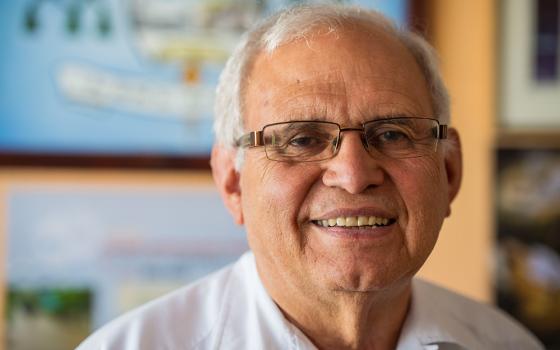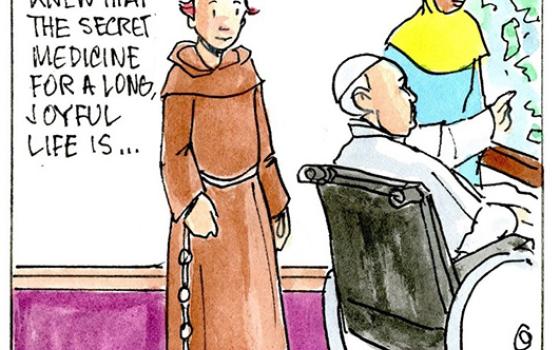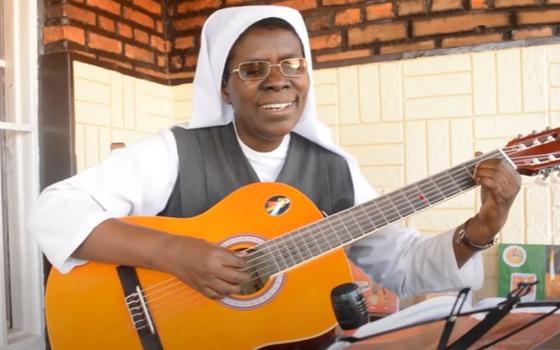Have you ever wondered what happens when a nun dies?
When I entered our community of the Daughters of St. Paul in 1967, only one sister had died in our U.S. (and English-Speaking Canada) Province since our foundation here from Italy in 1932. Her name was Sr. Mary Attilia Trevisan. She was born in Verona, Italy, in 1900; entered the community in 1929; made profession in 1933; arrived in the U.S. in 1934; and died in Staten Island, N.Y., on October 10, 1943.
She was buried in a borrowed grave at Calvary Cemetery in Queens. (In 1978, when the next two deaths in the Province occurred, her remains were exhumed and reinterred at our just-constructed mausoleum in Boston.)
For those who do not know about the Verona archdiocese, until fairly recent times, it was a priestly and religious vocation factory, sending out more missionaries, through numerous congregations, than any other diocese in the world.
Exactly one page about her life exists in the archives of our congregation in Rome. It attests to her dedication to bring the word of God through good books to families, workers, and prisoners.
What the one page, about 400 words, does not say is that she used to hover near the radio in the convent for news of the war because years had gone by without word of her family. In fact, she and another sister, unnamed, were in the Bronx that Friday, visiting factory workers and families.
When they were eating their sandwiches at the home of a benefactor of the community, listening to the radio for news, Sr. M. Attilia had a stroke. The superior of the community, accompanied by the superior of the priests and brothers of the Society of St. Paul, took a taxi to the Bronx and brought her back to St. Vincent's Hospital in Staten Island where she passed away soon after.
This information comes from listening to the stories of sisters who lived with her. She was very lively, they said, and used to test the patience of the superior -- eight years her junior -- by doing exactly the opposite of what she was told to do. The sisters who speak of Sr. M. Attilia do so with a smile, remembering her mischief and refusal to take everyday things too seriously. Then concern crosses their faces.
One sister, who was a postulant at the time, told me: "The Italian sisters used to tell one another to have faith because none of them were getting any news. But whenever she could, even during the night, Sr. M. Attilia would sit in front of the radio listening for anything about Verona. The lack of communication and news wore on her more than any of the others."
One photo of Sr. Mary Attilia exists.
This one sheet obituary, or notification of death, was sent to the communities who could receive it via the Vatican post because it was a time of war. This is noted on the document.
Sr. M. Attilia, like those of our 25 deceased sisters of our province, remains in our hearts via a leaflet in the archives of the Generalate in Rome, and the stories told by our senior nuns. I requested a copy of the leaflet, along with some other missing death notices of our sisters who died in the U.S. or who were stationed here for many years and then returned to Italy when they became ill.
I had the privilege of knowing almost every sister who has ever served in our province from another country, and certainly all those who entered in the U.S. -- from the very first one, Sr. M. Celeste Carini (who had two sisters who entered the Salesians) -- and stayed, to leave an indelible mark on our hearts and history.
A few years ago I was at the provincial house in Boston, which is where our novitiate is located, when a death notice was read to the large community after breakfast one morning.
One of our in-house comedians, who was standing next to me, muttered under her breath, "Yeah, here we go again. That's how we'll all end up. A leaflet in the archives." It made me laugh, but it is so true.
One of our sisters drowned in Lake Victoria, when she went for a boat ride during a picnic for religious and priests; another was delivering copies of our magazine to parishes in Bogota, Columbia, when the new-ish car she was driving stalled and was hit by an oncoming train.
Another, Sr. M. Alba Roagna (1930-2001), during a community meeting just closed her eyes and turned her head onto her shoulder, like she was nodding off. It was a month after 9/11; she had lost a good friend in the Towers and it affected her deeply.
But most of us go to our eternal reward by way of illness, as our co-foundress, Venerable Sister M. Thecla Merlo (1895-1963). I have seen sisters struggle with death, live years with dementia and go from being disliked to beloved, and I have seen sisters whose lives go out quietly, like a candle, consumed by love and passion for God.
The good news is that we continue to upgrade our obituary leaflet status. When a sister passes to her eternal reward, a one-page notice is emailed to all the houses of the congregation, and to every sister who has an email address. A hard copy follows to each house, with a color photo at the top, replacing the black and white images that were added perhaps in the 1960's. A mass is celebrated in each community for that sister as soon as it is possible.
Starting around 1963 each region asks a close friend or co-novice of that deceased sister to write a longer biography, with testimonies, that is edited into a booklet. The Generalate makes copies and sends these to each community in the world, translated into English, Spanish and French (the Chinese, Japanese, and Vietnamese are on their own). Even these booklets have a color photo now because the Generalate requests, that is, requires, a new color photo of each of us every few years.
In the 1980s, a photo album with almost every deceased sister in the congregation (now numbering at about 700), was compiled, and every year or so, we receive a packets of photos to add to it.
When a religious dies, there usually is not much left behind except memories, stories and the good that she accomplished, the holiness of her witness, but most known only to God.
When my novice director died in 1978, we were free to choose a memento from her belongings. I have her 14k gold thimble, given to her by her father when she was a trained seamstress who worked as a finisher at a sewing factory in the garment district in Manhattan before entering. I do not know to whom I will give it as no one I know sews by hand these days, never mind uses a thimble. I don't think many younger people entering religious life in the U.S. or Canada even know what a thimble is for.
Although some women enter religious life as widows, or less often as divorced women, with grown children and maybe grandchildren, most of us know and surrender to the anonymity that our legacy will be the good we hope we will have accomplished in the world, that cherished opportunity to make a difference.
True enough, a Mother Seton, Cabrini, Drexel or Teresa of Calcutta comes along once in a while to keep things interesting. But I bet neither they, nor any of us, care about becoming a statue on an altar or a medal around someone's neck.
Last Friday evening, at our community in Charleston, SC, we lost another sister to cancer: Sr. Cecilia Paula Livingston. I asked her younger sister, Sr. Jane, if I could share Cecilia's one-page leaflet on my blog, and she said "yes" as she feels it reflects her sister's legacy well. 
My hunch is that only a few of you knew Sr. Cecilia, but I would like you to. She was generous, hard-working, a daughter who loved her large family of origin and her congregation intensely, who leaves behind her grieving and loving parents and her fellow sisters.
What you don't see here is the suffering, both physical and that which comes with life, even life in a religious community. We strive to be saints but in so doing we are saint-makers, too. We strive to live well so that we can die well. The whole enterprise is a paradox -- a surrender to ambiguity, departing this life at the call of Christ, when we have nothing left to learn.
Sr. Cecilia made a difference and we cherish her memory.
May you rest in peace, good and faithful servant, sister, daughter, niece, aunt and friend. We thank God for your life, Cecilia, and are grateful for the lives of all religious -- past, present and to come.
An excerpt from the notice from Rome by Sr. Anna Maria Parenzan, the Vicar General of the Daughters of St. Paul:
Dearest Sisters,
tSurrounding her with the affection of sisters, friends and benefactors of the community of Charleston, U.S.A., at 3:30 this morning the Father of Light called home to heaven our sister:
born in Orange (California), U.S.A. on 18 February 1954.
A few days ago Sr. Cecilia's sister, Sr. Jane, superior of the Charleston community, wrote: "Sr. Cecilia Paula is waiting for the Lord. She has placed her life in his hands and is offering everything for the many needs of the sisters and of the Pauline mission. She says over and over again, 'The only important thing is holiness of life and mutual love. Compared with this, nothing else has meaning.'"
The attitudes of self-surrender, serenity and peace were hallmarks of the life of Sr. Cecilia Paula, a sister whom the United States Province could always count on for her maturity, feeling of belonging to the Institute and desire to make the most of the gifts with which the Lord had enriched her life. She entered the Congregation in the community of Boston on 15 June 1973. She made her first profession in Boston on 27 June 1976, followed by her perpetual profession five years later. Almost immediately afterward, she began to carry out the apostolate of capillary diffusion in Staten Island and New Orleans. From 1981-1984 she was in charge of the Boston typography, after which she was appointed superior of St. Louis. At the end of her term of office, she returned to Boston, where she once again worked in the typography, while at the same time serving as formator and teacher of the postulants.
So as to carry out her apostolic activities more competently, she participated in the Inernational Course for Postulant Formators held in Rome. Returning to the United States, she deepened these studies by taking summer courses for formators. Sr. Cecilia was aware of how positive these experiences had been for her, not the least because they helped her grow in courage, hope and greater interior freedom. She expressed her yearning to "repay" in some way all the resources that had been invested in her formation. When the Congregation launched its "Missionary Project," she indicated her willingness to carry out the Pauline apostolate wherever there was need in the English-speaking world. During that period, she received the gift of being asked to accompany the formation journey of 3 young Chinese religious, members of a local Congregation in China, who were living a period of updating in our Boston community. Sr. Cecilia Paula rejoiced to make this small contribution to improving the quality of the consecrated life in China. She was very hopeful that those religious would in the future be able to help the Pauline Family reestablish its presence in that immense country.
In 1996, Sr. Cecilia was appointed superior of the Boston community. When her term of office ended, she was made bursar of the Staten Island community and then was asked to manage the Alexandria book center. Wherever she went, Sr. Cecilia Paula radiated a profound joy that sprang from her intimate relationship with the Divine Master. With an attitude of self-surrender, in 2006 she accepted the need to assist her sick and elderly parents, taking a leave of absence from the Institute for this purpose. But while she was at home, she was diagnosed as suffering from cancer. Repeated chemotherapy cycles did not improve her condition, which she accepted with great tranquility while continuing to take care of her parents.
Last November, Sr. Cecilia asked to re-enter the Congregation, in spite of the fact that her parents' situation had not improved. The cancer undermining her system was moving ahead aggressively and she wanted to live the last period of her life in a Pauline community, where she could feel "alive" up to the very end. Up to almost the last, she took advantage of Skype to remain in touch with her family, friends and the people of Charleston, who rallied around her with great solidarity. A few days ago, even the mayor of the city dropped by to thank her, on behalf of all Charlestonians, for her beneficent presence among them and for the contribution of her prayers and self-offering.
For us too, Sr. Cecilia Paula is a shining example of peace and self-surrender. We are sure that from heaven she will continue to intercede for all her loved ones, for her province, and for all those whom the Lord entrusted to her great apostolic heart.




